#she lived in the late 1800s and was known to take fashion trends to the extreme as a form of sh
Explore tagged Tumblr posts
Text
Literally don’t talk to me about how uncomfortable Victorian women’s fashion was unless you’ve had a Victorian outfit tailor made for your exact measurements, you’ve broken in your corset, and you wear it for a whole day or I will stab you 13 times
#people acting like Victorian women didn’t work#smh#do they not see maids in tv shows and learn about women in factories in school#idiots#you think it would be possible to work heavy machinery if your corset is cutting off your air supply and chopping your liver in half??? NOOO#and what do you think women with heavy busts did??? THEY WORE A CORSET#BECAUSE THE PRIMARY FUNCTION OF A HISTORICAL CORSET IS BUST SUPPORT#if you really want to make a tight lacing story just make a retelling of empress sissy of austria#she lived in the late 1800s and was known to take fashion trends to the extreme as a form of sh#she had custom made leather corsets bought for her so she could lace herself tighter but they’d break in a week and she’d need a new one#her doctors and friends and family and maids begged her to stop but she never did#and tight lacing isn’t even inherently bad 😒 if you think it is then get ready to also boycott stiletto heels#bc stilletto heels hurt more than a tightly laced corset 🙄🙄🙄🙄🙄🙄🙄🙄🙄🙄🙄🙄
0 notes
Link
0 notes
Text
Women in Hip Hop: Empowerment
I define women empowerment as women taking control of their: minds, voices, bodies and sexuality. While they are empowering themselves they are also empowering others to do the same. Women empowerment started in the 1800’s with Women’s suffrage; women were fighting for their right to vote with leaders such as: Susan B. Anthony and Elizabeth Cady Stanton. This movement had very little to deal with black women. While a nation of women were fighting for their right to vote, they are still leaving out a race of women who could make a change as well. Sojourner Truth at the time was the voice for black women all around the world with her speech: “Ain’t I a Woman?” Truth was stated in her speech like white women, black women have rights and voices as well. Then there is World War II, where majority of the men in the United States were away fighting the war. Women had to “man up” and provide for their families, while their husbands were away. Working women of this time looked up to the poster: Rosie the Riveter. She exhibited a man’s strength but still had a feminine side. Then there were the 1990’s or the phrase: “I’m a woman of the 90’s.” Meaning that women are no longer going to live up to society’s misogynistic opinions. Women in the 90’s, started taking control of their voices, the way they were presented in the media and their sexualities. Female rappers such as: Lil’ Kim, Foxy Brown, Eve, Da Brat, Missy Elliott, Queen Latifah, and MC Lyte, made it okay for women to have voices and sexual creatures in a male dominated industry. Women in hip hop serve as a symbol of empowerment and self-definition rather than misogyny.
For years’ women of color in the media and/or hip hop have been depicted to be; weak, voiceless, disposal, and sexual objects. Society has made it seem that a black women’s voice does not matter. As Audre Lorde once said, “If I didn’t define myself for myself, I would be crunched into other people’s fantasies for me and eaten alive.” An empowered woman is empowered because she knows the definition of herself. She can explain who she is to society, she is secure and knows her self- worth and empowered woman knows that her voice will be heard. A weak woman does not know the definition of herself, she does not know her worth nor does she know that she has a voice. A weak woman will spend her whole life trying to create a version of herself that is not authentic, so she can be accepted by society. Therefore, she will be eaten alive because she has spent her whole life not knowing her true definition.
In the late 80’s and earlier 90’s a pattern of female rappers, started a trend of taking control of their voices and letting men know that black women will be respected. Queen Latifah’s: U.N.I.T.Y. made it clear that black women are more than derogatory names and that they have voices that need to be heard. Mc Lyte’s: I Am Woman, stated that just because she is a woman does not mean I cannot make her mark in the male dominated industry of rap. Yo-Yo: You Can’t Play with my Yo-Yo, simply stated that women are more than sexual objects and they need to be treated with respect. These rappers not only changed that hip hop is a male dominated sported, but they also gave women that were once voiceless that could not express their problems a voice. These women helped paved the way for other female rappers that would later help further empower women of color and change the rules of hip hop. An excerpt from the book It’s All in the Name: Hip-Hop, Sexuality, and Black Women’s Identity. Talks about how the evolution of black women in hip-hop and black female artist did empower black women around the world. The author argues that today young black girls do not have that, all they hear today are female artist telling them to use their sex to get a head in life. This argument could not be more wrong. Female artist such as Trina, Nicki Minaj, Dej Loaf are not rapping about using their sex to become more successful. They are simply doing the same thing men have been doing for year and that is put black women in category where they can be only seen as sexual objects.
Reversing the male fantasy is something that not only female rappers have accomplished but also a few R&B singers have been able to do as well. Beyoncé released a song called, Blow. Blow is often the slang term used when a man has received or wants fellatio, but Beyoncé took the term to refer it to her receiving cunnilingus. Also hinting that she is in the dominant position while her partner is being the submissive one. Lil’ Kim does the same in her song: Not Tonight, she raps about her many sexual escapades. Although throughout the song she raps about how her partners have pleased her sexually, there is only one thing she truly wants from them and that is oral sex. Kim also states that she only using them until she gets what she wants, but in a sense she is coming for their manhood as well. By stating the he’s a punk if he does not do this for her. Lil’ Kim is taking charge of her sexuality by rapping about what she wants, similar to male rappers. Foxy Brown has also reversed the male fantasy, in Jay- Z’s song Ain’t No N***a. Brown raps, “Remember the days you was dead broke. But now you style and I raised you. Basically made you into a don.” Brown is stating that she was there when no one else was there for him. Now that her man has money he wants to front and forget about her, she is also saying that she raised him into the man that he is today. Brown’s method is similar to what men do when a woman is done with them. He will remind her of all the things that he has done for her to make her better or elevate her life style and that’s what Foxy Brown did.
Fashion for women in hip-hop has always been a thing to look forward too. Many critics argue that female rappers who don’t have on as many clothes are and will be objectified. That these female rappers are whores and setting a bad example for the young girls that watch their music videos. When in actuality these rappers are setting the example that you do not have to always conform to the wants and demands of society. Female rappers are also stating that women, no matter what size they are should feel comfortable in their skin and confident enough to wear she wants.
Melyssa Ford who is one of the highest paid video vixens, believes that what she is doing is empowering women to take control. Balaji states, “Although video vixens have been typecast as the sexualized other, some have acquired a degree of fame outside of music videos and have taken ownership in self-definition.” Most video vixens are only looked at by society as disposal sexual objects and that they have no respect for themselves. A lot of vixens seek fame outside of being in music videos. Some women take on a career of being a video vixen, and a lot of them go in with the mindset that they are going to make millions, so they depend on that as their only income. Others do not only depend on a vixen career, they also want to build and make it bigger. Women who already know what they want, have a game plan: be a video vixen long enough to get their names floating in the right places, then they begin to rub elbows with the right people, then they begin to get bigger video gigs and get a lead role in the next big rappers video. Most video vixens know their self-worth and know their limits. To them it is like a business deal, to see what video producer can give them the best offer the quickest.
Black women have struggled with self-definition, which is mainly because of how they are presented in society. When a woman does know her self-definition, she will always let her voice be heard. The term “I” is always in their vocabulary, to not only express how they are feeling, but to remind society that they have high self-esteem and self-perception. Ford states in an interview, “I would turn down videos that were too misogynistic or when I just don’t like the artists.” Here Ford is showing us her self-definition, by sharing that every music video she was offered she did not accept. Ford knows her boundaries and who she is as a person.
Many critics believe that Keran Steffans and Melyssa Ford express synonymous values and views, when it comes to a music video modeling career. It may appear that way, but when Steffens’s Confessions of a Video Vixen was released, which is a tell all novel about her escapades with celebrity men. Generalized black women into a category that they too often compromise their values to be identified by their sexual prowess. The downfall for Steffans career is that she started getting her career and personality intertwined. At the peak of her career she turned to drugs.
Although all these points are valid, it fails to mention that Ford grew up in a two parent household and attended York University where she was majoring in Forensic Psychology. This argument also overlooked the fact that Ford stated, “Doing videos was only a part-time interest for me.” Ford had no real desire to presume a music video modeling career unlike Steffans who let the industry consume her. Another valid point the argument above fails to realize is that Steffans was a stripper turned video vixen and at the peak of her career became addicted to drugs. Where Ford was working as a bartender when she was discovered and her vixen career took off. The big difference between Steffans and Ford that was failed to be mentioned is that Ford does not let her job consume how she is in real. She explains that she was never the fun girl on set and that when the camera is on she is in character.
In conclusion, women in hip hop serve as symbols of empowerment and self-definition rather than misogyny. Women like: Sojourner Truth, Melyssa Ford, Lil’ Kim, Foxy Brown, Beyoncé, Queen Latifah, Mc Lyte, and Yo-Yo and many more are an empowerment to women of color. They not only challenge the views of society, but they have let it be known that black women have voices and take control of their bodies and sexualities. They have also helped women realize that they are more than disposal, voiceless, and sexual objects. Black women can be sexy without being considered whores that women of color are educated and have voices just like any other race of women. Black women in hip hop are an empowerment that society needs to pay closer attention to.
129 notes
·
View notes
Photo
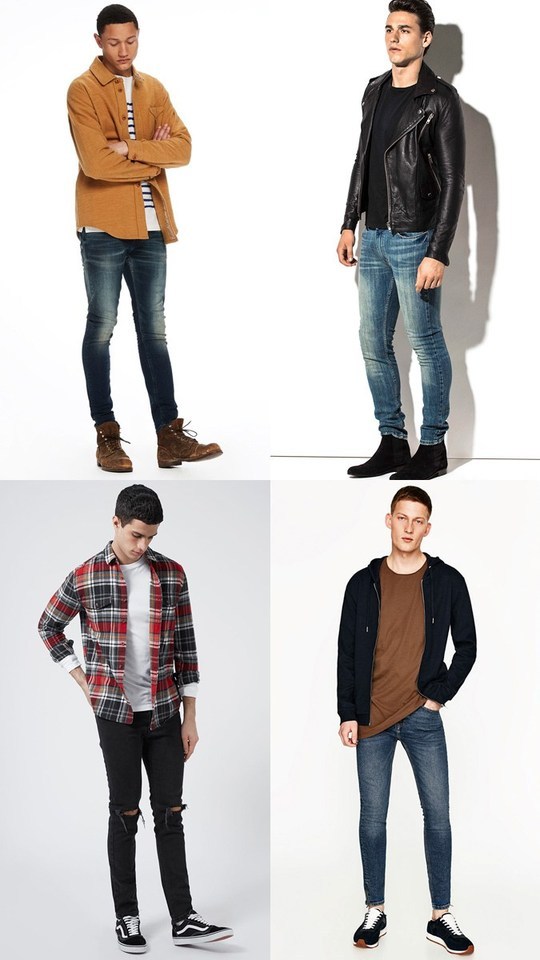
https://hair-terminator.com/the-best-skinny-jeans-brands-in-the-world-today/
The Best Skinny Jeans Brands In The World Today
The skinny jean lives. While Balenciaga, Dior Homme and other headline-grabbers of fashion push wide-leg ‘dad’ fits, high street shop windows, internet shop windows, any given night down the pub prove skinny is still very much in circulation. Speaking of which, not all skinny fits need cut
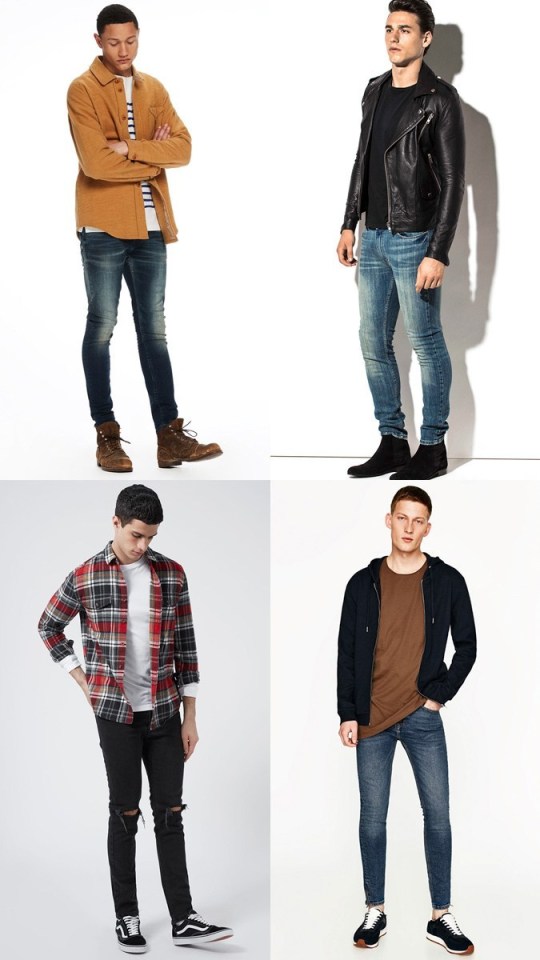
The skinny jean lives. While Balenciaga, Dior Homme and other headline-grabbers of fashion push wide-leg ‘dad’ fits, high street shop windows, internet shop windows, any given night down the pub prove skinny is still very much in circulation.
Speaking of which, not all skinny fits need cut yours off. Thanks to the lean jean’s enduring popularity, brands have rushed to develop a slew of new fabrications and shapes that promise your legs (and the family jewels) more comfortable wear. From slim and tapered selvedge to skin-tight spray-on, there’s a style to flatter every man.
(Related: How To Pick The Perfect Jeans For Your Body Type)
It’s not a stretch to see why the skinny jean has stuck around, either. After all, what other jeans offer you warmth, style and a little body-enhancement? (Don’t lie, we know.)
The Skinny On Skinny Fits
A staple of the Beatnik wardrobe, skinny jeans first shot to fame around the 1950s – their leg-hugging fit a proud point of difference for men who considered themselves stylishly counter-mainstream. But it wasn’t until the 1970s, when punk spewed onto the scene, that skinny fits took their limb-compressing hold. Today, they’re a staple, thanks largely to Hedi Slimane’s stint at Dior Homme in the early 2000s, otherwise known as the Skinny Jean’s Second Coming.
“Skinny fits have been adopted into the offering of pretty much every denim brand,” says Fraser Trewick, founder of premium workwear brand Hawksmill Denim Co. “And although its popularity may fluctuate [from season to season], it will always be present in the market.”
Why? Because skinny jeans have gone from left-field to front row. In 2018, wearing a pair of black skinny jeans isn’t so much a provocative statement as proof you have a classic taste in clothes.
What’s more, skinny fits offer something many other jeans can’t: a look-twice silhouette. “Skinny styles are great because their narrow line provides a platform on which to play with more directional tees, sweatshirts and outerwear,” says Topman buying director Rachel Morgans.

How Skinny Is Skinny?
The best litmus test for finding out whether or not a pair of jeans is for you is to try them on. But if you’ve been a bootcut man until now, you may also find this primer on fits of use when delving into a whole new world of denim.
Slim. Narrower than straight-leg jeans, but with room for your junk to breathe. Slim jeans taper slightly from the thigh all the way down to the cuff.
Skinny. Tight, throughout. How tight? Enough that you should be prepared for hair on the outer sides of your lower legs to stop growing if you wear them daily. Cool enough that they’re worth it, though.
Muscle. For men who got back (and quads of steel). Often cut from a combination of lightweight cotton and elastane to comfortably contain your gains.
Carrot. Like its vegetable namesake; broad at the top, gradually narrowing towards the bottom. Not necessarily orange, mind.
Spray-on. They’re leggings, basically – but with a fly. Imagine wrapping your legs in cling film, but instead of cling film, it’s slightly elasticated cotton.
What To Look Out For
When it comes to assessing the quality of a pair of skinny jeans, there are two key things to consider: comfort, and resistance to wear. The former because you’ll be encasing your testicles in this denim, and the latter because friction is one of the main causes of warped shapes and crotch holes.
If you’re stuck for time, or just simply can’t be bothered with the changing rooms, Topman’s Morgans has a handy trick for testing comfort. “Take one of the jean’s legs and, with one hand on each outside seam, gently pull to see just how much the jean stretches,” she says. That’ll give you an idea of how flexible, and therefore wearable, they are.
“Now, release, and check to see if the out seams return to their default position, or display a slight wobble as a result of being stretched.” This, according to Morgans, is the best way to gauge the jeans’ recovery. “The closer the outseams are to their original position, the less likely you are to see bagginess in the knees and seat after a few wears.”
Finally, check the weight of the denim – and no, you don’t need scales. Simply use your thumb and index finger to get a good feel of the denim itself. If it feels light, almost papery, then it’ll fit like a super-comfortable sausage skin, but will probably wear through within a few months of heavy wear. As jeans become thicker and heavier, they become more difficult to wear-in but will generally last longer.
(Related: The Best Affordable Jeans Brands)
The Best Brands For Skinny Jeans
Uniqlo
Knitwear, underwear, cotton T-shirts in pretty much every colour imaginable – when it comes to quality basics, Japanese giant Uniqlo won’t be beaten on price. And luckily, that promise extends to denim.
In fact, so dedicated to the craft is Uniqlo that it opened its own Denim Innovation Centre in Los Angeles in 2016. There – under the exacting eye of director Matsubara Masaaki – teams of denimheads concoct and continuously refine wardrobe essentials like the retailer’s selvedge slim and ultra-stretch skinny-fit jeans, which are then made available to you for a song. Win.
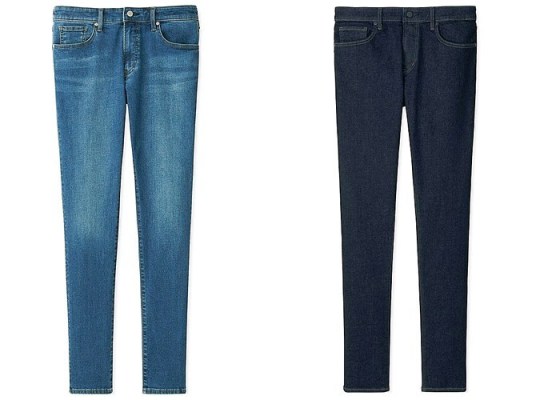
Topman
Proudly the hottest on high-end trends, Topman was one of the first high street brands to pounce when Hedi Slimane sent skinnies down the runway more than a decade ago, swiftly garnering a name for itself as the destination for a pair of jeans to pour yourself into.
Today, the British stalwart’s offering has exploded. From acid wash with rips to slate grey biker styles, you’ll find around 40 skinny variations, starting from just £30.
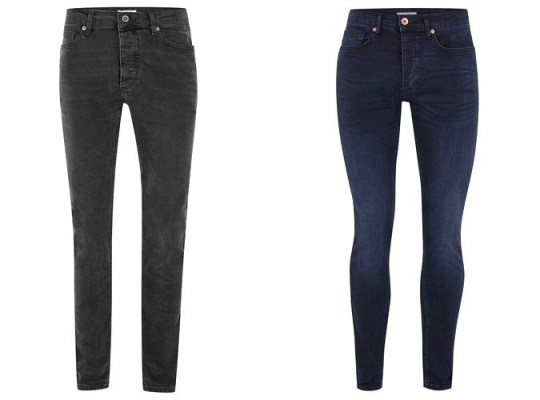
Levi’s
Otherwise known as the OG of jeans, stateside brand Levi’s has been equipping men with quality indigo since the late 1800s. Though it’s probably best known for its shrink-to-fit straight-leg 501s, the granddaddy of denim boasts an expansive selection of skinny fits too, including its beloved 510s.
Crafted with just 1 per cent elastane, this brand’s skinnies might not ‘give’ as much as other manufacturers’, but we’d wager their crotch will hold up a hell of a lot longer.
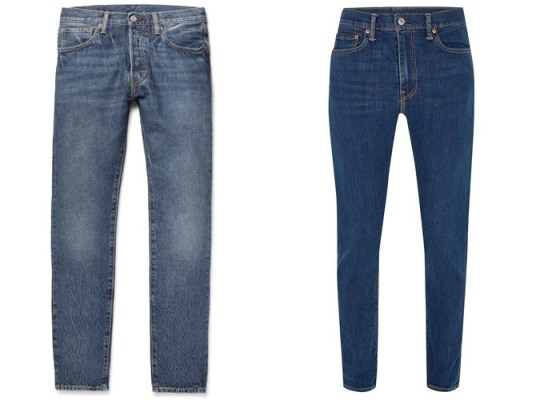
Nudie Jeans
Few brands are as synonymous with denim as Nudie Jeans. Founded in 2001, the Swedish label might not have the heritage of some of the other names on this list, but it hasn’t let that hold it back.
In fact, you could say its relative newcomer status is exactly what inspired some of its most commendable points of difference in a crowded market. Nudie only uses 100 per cent organic cotton to produce its wares, ensures the workers who make them are fairly treated and paid, and also offers a free repair service at several of its stores. Your move, Levi’s.
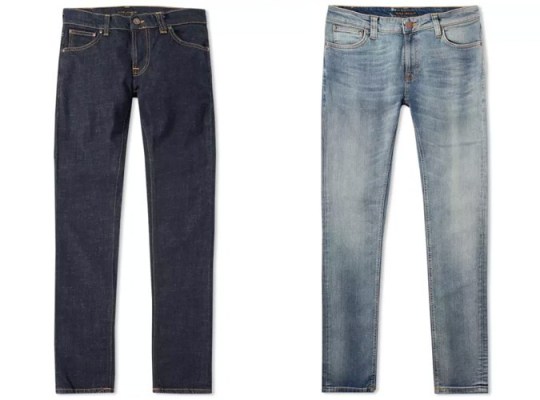
Cheap Monday
If you like your denim comfortable and cheap (and who doesn’t?), then this H&M-owned brand should rank high on your hit list. With super-skinny, skinny and slim-fits starting from just £49, Scandi favourite Cheap Monday carries some of the most stylish skinnies at prices that’ll keep your wallet fat.
Most are made from a combination of lightweight cotton and at least 2 per cent elastane, which means not only do they wrap closer on your body than heavier denim, but there’s none of that cramp-inducing constriction either.
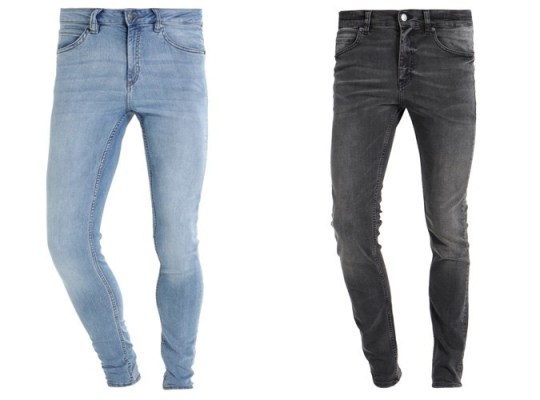
Hawksmill Denim Co.
Searching for something more slim than skinny? Look no further than this Brighton-based outfit, which prides itself on raw and selvedge styles with a slight taper.
Helmed by Fraser Trewick – a denim veteran who helped launch Nudie Jeans in the UK – Hawksmill Denim Co. manufactures its jeans exclusively in Europe from non-stretch Italian and Japanese denim. Which means they won’t lend your legs the super-sharp silhouette of a pair of stretch skinny jeans, but they will, with a little TLC, last a lifetime.

Frame Denim
West Coast cool meets Scandi minimalism in the LA brand started by two of fashion’s most pioneering polymaths. Not content with founding Saturday Group – a fashion empire comprising magazines, a major creative agency and more – Swedes Erik Torstensson and Jens Grede set up Frame Denim, a tightly curated luxury clothing line designed and produced entirely in Los Angeles.
Choose from skinny and slim fits in an array of washes, safe in the knowledge you’re wrapping your gams in the same jeans as A-listers including Jamie Dornan, Jay-Z and Kanye West.

Wrangler
Unlike others, Wrangler jeans are actually making America great again. This North Carolina-founded brand, particularly beloved of anyone who was of jeans-wearing age in the 1990s, makes good on its claim of all-Americanness, supporting grassroots organisations from the Women’s Professional Rodeo Association to the American Quarter Horse Association.
Most importantly, however, it also makes quality skinny jeans that, while not exactly trendsetting in their design, will be the workhorses of your wardrobe for years to come.

ASOS
For the sheer choice of styles and fits – not to mention prices that won’t see you weeping into a tin of baked beans a week before payday – ASOS comes up trumps.
Not only is the global e-tailer’s skinny offering on the money when it comes to trending details – think knee rips, distressing and neutral colours – but its Plus styles make it possible for bigger built men to get in on the action, too.

Fear Of God
The jeans former sports agent Jerry Lorenzo designs might cost as much as a month’s rent, but denim this grail doesn’t come cheap. With 1.1 million followers on Instagram and celebrity fans including David Beckham and Travis Scott, Fear Of God has managed to do for denim what other brands couldn’t: shed its roving cowboy/workwear vibe in favour of a zeitgeisty streetwear slant.
If you’re copping, swerve the entry-level styles and cough up a little extra for a pair of painted jeans that were born to stunt.

Edwin
Known for popularising Japanese selvedge denim (not to mention some choice TV ads starring Brad Pitt), Edwin started out taking its cue from American jeansmakers in the 1950s. Now, seven decades on, it’s arguably beating them at their own game, producing exactingly crafted selvedge jeans – some of them even at home in Japan.
Try the ED-80 or ED-85 slim, tapered selvedge styles, or for a snugger fit, pick up a pair of the EW-70s, made from Powerstretch Denim (that’s cotton and elastane to you and us).
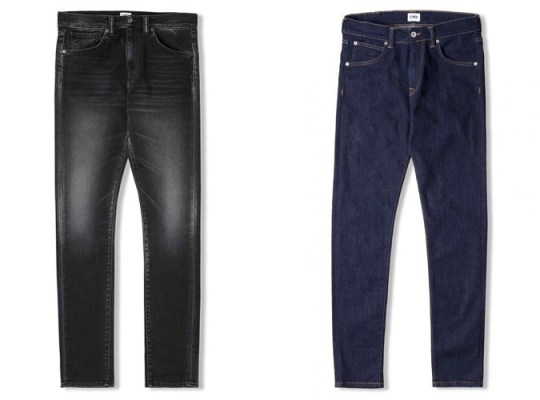
River Island
The high street stalwart’s prices are famously low, but that doesn’t mean you’re getting a sub-par product. River Island relaunched its entire denim offering in 2017, keeping a focus on skinnier cuts including super-skinny and spray-on styles.
Whether you shop in-store or online, expect a mind-boggling array of washes, too, as well as all the rips or distressed touches you could want (or not).

Paige Denim
Californian street cred is more commonly linked with skaters, medicinal weed or skaters on medicinal weed. Paige, however, is but one denim brand to polish up the profile.
The label has peddled skinny jeans since 2004, partnering with only the most reputable wash houses in the US with a rigorous wear-testing process for ultimate durability.

AG Jeans
AG Jeans launched in the year 2000 when Adriano Goldschmied (the man who created Diesel and Replay) partnered with seasoned denim manufacturer Yul Ku.
This refined, contemporary denim brand prides itself on supplying seriously premium clothing, focusing on the two only things that truly matter: fit and wash.
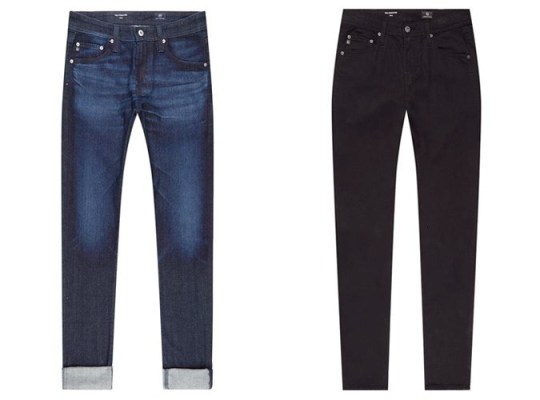
0 notes